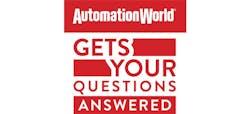Read the full transcript below
David Greenfield: Welcome to the Automation World Gets Your Questions Answered podcast, where we connect with industry experts to get the answers you need about industrial automation technologies. And you can find even more answers by subscribing to automation world at Subscribe AutomationWorld.com
I'm David Greenfield, Director of Content for Automation World. And the topic we'll be looking at in this episode is investing in automation. And joining me for this discussion is Jim Carlisle, Managing Director at Thomas H. Lee, a Boston based private equity firm, often referred to by its acronym, T H. L. Jim heads up THL’s Technology and Business Solutions vertical, and the firm's automation Fund, which invests in automation technology and services company. So thanks for joining me today, Jim.
Jim Carlisle: Thanks, Dave. It's a pleasure to be with you today.
David Greenfield: So Jim, before we get started, I just want to take a second to note for our longtime listeners of this podcast that, you know, we typically focus on answering questions submitted by our readers about automation technology. So this podcast episode is a bit different. I haven't covered the industrial technology area for more than 30 years now, I haven't seen the level of targeted investment interest in this sector as high as it's been now over, probably the past five years or so. So that's why we're connecting with you, Jim, to get an investor's point of view on the automation technology market, and how that can affect the technologies that our listeners use.
Jim Carlisle: I appreciate that. And it is a lot of fun to read your publication and listen to what you talk about on your podcast stuff. So thanks again for having me on today. David Greenfield: Yeah, thank you again, thanks for joining us. So with all that said, you know, let's let's start by looking at th L's automation fund that focuses on hardware products, like robots and machine vision is as well as related software and services. You know, can you explain in a bit more detail the kinds of investments in industrial automation that THL is focusing on and why?
Jim Carlisle: Sure, we have investments in robotics, as you said process automation, AI and loT are orchestration and control software, IoT. And you know, there's certainly a lot of acronyms there. I appreciate that and guessing your listeners are familiar. But we're investing in those technologies across a range of end markets deployed in agriculture, construction, ecommerce, logistics, manufacturing, semiconductors, warehouses, the list goes on and on, actually, outside of industrial automation, our investments and our focus also includes health care, insurance content, and many other in markets. So you know, look, I appreciate that's a mouthful, Dave, but I can answer why we're interested in industrial automation, and really plain English. Automation is as powerful of the technology trend as we can find. In fact, we've seen research suggesting that automation could drive a third to a half of global GDP growth over the next few decades, all from productivity improvements. It's a really exciting area.
David Greenfield: So Jim, you know, having you know, from my end, I've been covering the space now, as I mentioned earlier, you know, for a little over 30 years now, and it seems like this level of investment has really picked up visibly anyways, like I've mentioned in the past five years or so. Is that what you're seeing, too? Is this recognition of what or do you? Is it that the technology has advanced enough in the eyes of at the investment community to get this kind of attention? Or is it always kind of been there in the background, but it's just becoming more visible recently?
Jim Carlisle: No, it's it's a great point and insightful question. I you know, I comment maybe on both the demand side and the supply side. So on the demand side growth, investors look to identify the secular growth trends that are most likely to sustain over a really long periods of time and across economic cycles. Automation fits that bill. And so there's demand from the investment community for good automation businesses. Maybe more insightful is the supply side and you ask this in your question, are there enough automation companies that are seeking investment that fit the parameters of what a firm like ours may be interested in investing behind? And as part of our process, you know, we're absolutely adamant about listening to the voice of the customer going out in doing market research about different types of automation, businesses and technologies. And we're seeing that across technology types and across in markets, that customers are seeing really strong returns on new automation investment. And so as we've watched companies in this space over the course of the past few years, we're starting to see migration from pilots to broad based deployment and customer facilities. And that rapid scaling can require new expertise. And as a result, management teams or founder owners of business, businesses are excited to seek investment from someone like us, who has not only capital which can accelerate investment, but also the ability and the resources to help that company scale that's attractive. We, we hope that we can help companies win in the marketplace. And as a result, there's a good fit the demand and the supply intersect and more investment happens.
David Greenfield: So how big is this automation fund at THL? And what are the plans for moving forward at this point?
Jim Carlisle: Our Automation Fund is a $900 million equity fund. Though, including all of our equity sources, including our multibillion dollar flagship funds, we have invested at THL over five and a half billion dollars of equity in automation companies over the course of the past five or six years. What's exciting to us about the automation fun Dave is it gave us the ability to invest in all types of companies in different life stages, geographies and in markets. Our flagship funds were largely middle market, full bio funds, whereas our automation fund has more flexibility. So our plans with that fund is really pretty simply to continue to invest behind market leading companies and to work with those companies and their management teams to help them accelerate growth to help them scale.
David Greenfield: Okay, now, in the description of th ELLs automation fund, the company notes the positive effects from industrial automation to address labor issues, production efficiency, and of course, throughput, you know, all of which are fairly well recognized. But THL also notes, the impact of automation on business resiliency, can you explain that and how it figures into your investing outlook?
Jim Carlisle: Sure. So, you know, I think we just wouldn't describe resiliency is the response to changing conditions or bouncing back quickly. And automation enables immediate response, there's no lag between decision and action, no need to recruit no need to lay off people in order to drive change. So I'll give an example if it's helpful. The onset of the pandemic created both a paradigm shift in the availability of labor as well as a massive change in consumer behavior. And with automation, companies were able to increase capacity in response to accelerated demand, even without incremental labor. Take auto store, customers could add robots to the grid, they could increase the runtime and quite quickly, they could expand the number of automated facilities to meet that demand. Resiliency was driven by automation.
David Greenfield: Okay, thanks for clarifying that, Jim. So, you know, beyond helping, you know, directly helping automation technology companies gain traction in the market or advanced development of their technology, how do you see large investments you know, of the type that THL engages in impacting the automation supplier market itself? For example, you know, do you see your investment helping accelerate the development of industry 4.0 or digital twin technologies? Or do you see THL as more of a follower of industrial technology trends that you then invest in?
Jim Carlisle: Now, that's a big question, Dave, I absolutely believe we can impact the market itself. I know that's a bold statement. So I'll try to explain why. Over the past 15 years or so THL has built operating capabilities and an executive network internal resources of THL that are designed to help accelerate growth in companies in which we invest. We work with management teams to improve their go to market functions to facilitate in increased investment in r&d and product to build their organizations and attract talent and to drive mergers and acquisitions. And our goal for those investments through our partnership with management is to contribute to faster market adoption by customers. And faster market adoption attracts more investment. And then more investment drives incrementally more adopt adoption. There's a flywheel effect there. There's compounding interest in in development of the market itself as we work with businesses to try to take advantage of the opportunity that's in front of them to leverage the technologies that they've invented to solve customer problems.
David Greenfield: So based on your investing outlook strategy, as you're just describing, you know, what do you see coming for the automation industry as we learn to deal with COVID on an ongoing basis, and amid all the current economic issues, and China, the war in Ukraine and industry is ongoing issues with attracting and retaining workers.
Jim Carlisle: Those are all meaty issues, Dave, but it's one of the reasons are many of the reasons I should say that we're excited about investing in automation. There are five big macro challenges that we track, and all of which we think can be partially mitigated or positively impacted by automation. You touched on a bunch of them labor shortages, inflation, de globalization, sustainability, supply chain constraints, you know, we probably don't have time on today's podcast to get into each one of those. But, you know, happy to pick one and talk a little bit more about it.
David Greenfield: Yeah, if you could maybe, I think supply chain is a is an obvious one that's being impacted by a lot of those issues. Can you highlight that a bit?
Jim Carlisle: You bet. So, you know, I recently saw a survey of Supply Chain Leaders on a global scale as to what their most important priorities were for the next 12 months. And, you know, you could think about the range of of answers to that question, given the shortages that many companies are dealing with, and so forth. And the number one priority in the next 12 months was investment in automation. Number one, automation allows companies to act faster, to make better decisions with their data, and to improve their visibility and operations. You know, as we discussed before investment in automation drives resiliency, we have a company called for kites in our automation portfolio, that is a supply chain visibility tool, it's being adopted by customers, to help them deal with complexities in the supply chain. Automation is absolutely a solution.
David Greenfield: As you've mentioned, when we first began talking, you know, everything from the industrial technologies to the office side, like robotic process automation...are the automation technologies that are referred to by these various Supply Chain Leaders you were referencing, are those more industrial type or and probably software analytics business analytics software? Or is it other types that they were referencing when they said that automation was their number one target of investment?
Jim Carlisle: You know, I think it's both Dave. So you can certainly use pure software platforms to drive better data flow and information. But also investing in the hardware and the technology across a supply chain can improve throughput. It can drive a faster transition of good to consumer good to business, which can help mitigate some of the supply chain issues that we're all facing.
David Greenfield: So thanks for all your insights you've shared today, Jim. So I think just a wrap up the discussion. You know, can you speak to how the market corrections we're seeing now and the ongoing discussions of potential recession? are impacting th ELLs investing outlook in the automation sector for the foreseeable future?
Jim Carlisle: Sure, so I guess I'd start by saying that valuation corrections can be healthy. But like many healthy things that can take some time before you start to feel better, it's not necessarily the most fun at the beginning. You know, we see three major impacts on valuations over the course of the past several months. And number one, are the macro challenges that you asked about earlier, Dave, which just create global uncertainty and investors don't like uncertainty. Number two, interest rates are rising largely in response to inflation, and rising interest rates drive down valuation just based on the discounted cash flow math. Number three, we're seeing investors shift back to growth and profitability, in preference to growth at all costs. It may be a topic for another podcast, Dave, so I'll maybe just close with the age old advice that we try to embrace both at THL and with our portfolio companies, particularly when we see the volatility that we've experienced in the past few months. We say control what you can control valuations may have Come down, but you can still make money the old fashioned way driving growth by solving customers problems. And for that automation is a great sector.
David Greenfield: Well, thank you for joining me for this podcast. Jim. And thanks of course to all of our listeners. And please keep watching this space for more installments of Automation World Gets Your Questions Answered. And remember that you can find us online at AutomationWorld.com. And subscribe to our print magazine at SubscribeAW.com to stay on top of the latest industrial automation technology insights, trends, and news.





